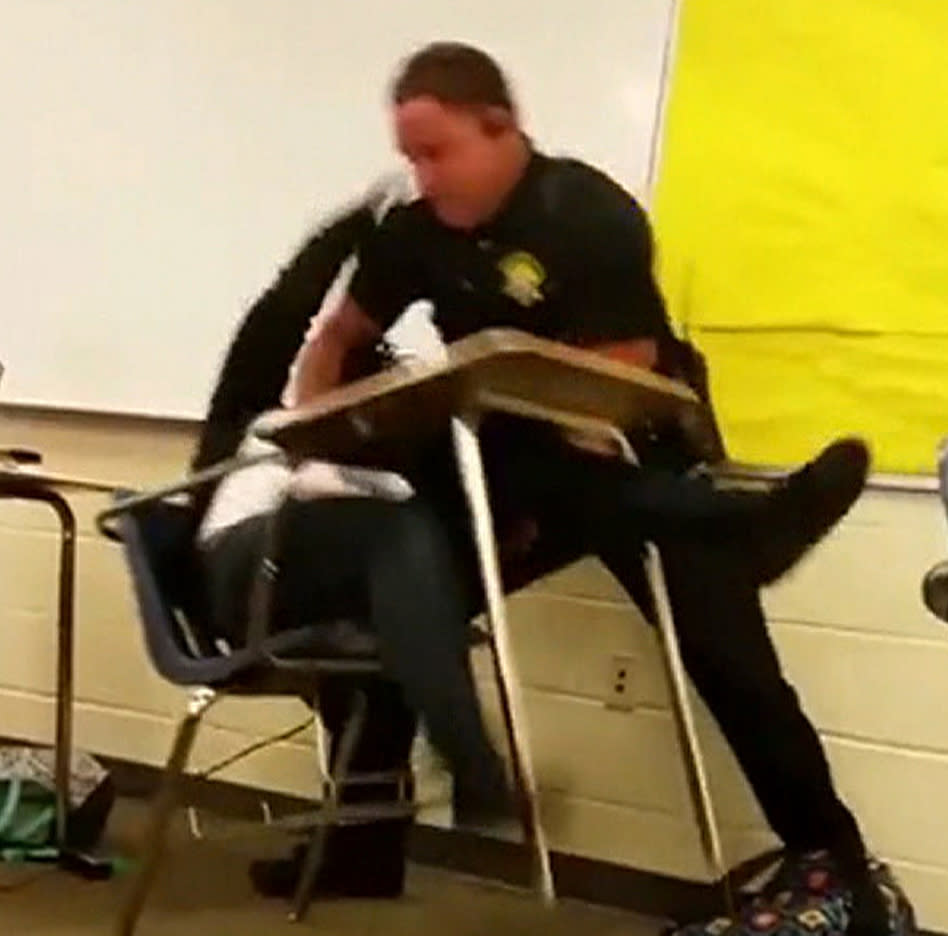Police in schools have outsize effect on Black children, report says
The presence of police in schools actively jeopardizes the safety of Black students compared to their counterparts of other races, according to a report published this month.
Black students were subjected to more than 80% of the incidents of police violence accounted for in the survey, which analyzed more than 285 incidents over a decade. At least 60% of police assaults on students resulted in serious injury to the students, including broken bones, concussions and hospitalizations. The report also cited 24 cases of sexual assault on students and five student deaths as a result of police force in schools. It was published by the Advancement Project, a civil rights organization, and the Alliance for Educational Justice, a coalition of groups working toward equity in public schools.
“It’s not just the fact that school policing is ineffective and a major waste of public funds. It is also harmful to the physical and emotional safety and health of students of color throughout the United States,” said Tyler Whittenberg, the deputy director at the Advancement Project.
The groups rounded up every identifiable reported incident of police violence in schools from 2011 to 2021, but the organizations concede their data is likely to be based on an undercount.
The report is named “#AssaultAtSpringValley, after a 16-year-old Black girl attending Spring Valley High School in Columbia, South Carolina, was placed in a headlock and flipped over in her desk, then dragged and thrown across her classroom by a school police officer in 2015. It was in response to allegations that she was being disruptive and refusing to give up her phone and leave the classroom.
The school district fired the officer; two years later, a Justice Department investigation determined there was insufficient evidence to pursue federal charges.

Former Spring Valley student Niya Kenny was 18 when she witnessed her classmate being dragged. She encouraged other students to record the incident and later was arrested and charged with disturbing a school. The charges were dropped, but she never returned to the high school and opted instead to get her general equivalency diploma.
“I remember not wanting to go back to Spring Valley,” Kenny said. “I was confused, puzzled and terrified why a police officer was using that much force on a young student.”
Janel George, the director of the Racial Equity in Education Law and Policy Clinic at Georgetown Law School, said it’s hard for students who both experience and witness policing in schools to re-engage with the classroom.
Whittenberg said: “In general, Black students are often viewed as the problem and as needing some sort of disciplinary treatment in order to act correctly. It is flat-out racism that now we can quantify with studies like this.”
Police violence in school is much more likely to affect Black girls specifically. Black girls are four times more likely than their white peers to be arrested, three times more likely to be referred to the police and twice as likely to be physically restrained, according to the report.
A heavy police presence has also been linked to the school-to-prison pipeline, which refers to policies and practices that indirectly push students into the criminal legal system, among them harsh and strict punishment like arrests and expulsions.
“When they attend schools where they’re seen as a threat and are targeted by police officers as they walk to and from their classes, what else would they take away from that other than this system is really not meant for me?” Whittenberg said.
He said suspensions and expulsions alienate students from their peers and remove them from pro-social relationships.
Whittenberg said the use of police officers in schools that mainly serve communities of color creates the idea that students of color need to be controlled and dominated to act properly.
The report also revealed that officers generally face few to no consequences for assaulting students. In the 10% of cases in which officers faced consequences for assaulting students, firings or criminal charges were rare. Instead, they usually faced only internal reviews or reassignment or being placed on leave.
“That’s not surprising, because, unfortunately, this has been occurring for such a long time, and the research has long demonstrated how Black students are disproportionately targeted for this kind of policing,” said George, who once worked to reform discriminatory school discipline practices at the NAACP Legal Defense and Educational Fund.
Whittenberg said he hopes the report creates change in the conversation surrounding removing police from schools.
“I hope that this report can be used to demonstrate that it’s not a one-off incident and that this is actually a systemic issue that will continue to happen as long as police are present in schools,” he said, “especially those schools serving Black and other students of color.” Follow NBCBLK on Facebook, Twitter and Instagram.
